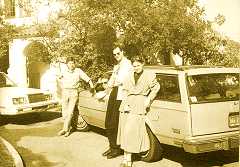Air of another planet
A quarter century of musical conviction
The Schoenberg Quartet celebrates a milestone
Niek Nelissen
Fundamental changes affecting the Schoenberg Quartet
 The successes achieved by the Schoenberg Ensemble and Schoenberg Quartet at the end of the eighties were overshadowed by an increasing problem. According to Henk Guittart, it was becoming more and more clear that the working relationship between himself and Reinbert de Leeuw had become troubled. Discussions with parties directly involved make it clear that even after ten years there is no agreement as to the substance, extent or even the nature of the problems that existed in this period. It is debatable whether this jubilee is the right occasion for the documentation of a painful chapter, although even aside from that, it appears to be impossible to arrive at an objective account of the events in question. Conversations with the quartet members indicate that they have no desire to open old wounds. What does emerge is that feelings certainly ran high. Decisive moments were reached in 1988,1990 and 1991. In 1988 Henk Guittart decided to withdraw from the artistic management of the Schoenberg Ensemble, staying on another two years as an active member of it. In November 1990 Guittart played for the last time in a concert given by the Schoenberg Ensemble, and in May ’91 he left officially. Having departed from the ensemble Guittart devoted himself entirely to the quartet, which achieved independence during the same period. On March 8 1991 the Schoenberg Quartet foundation was formed.
The successes achieved by the Schoenberg Ensemble and Schoenberg Quartet at the end of the eighties were overshadowed by an increasing problem. According to Henk Guittart, it was becoming more and more clear that the working relationship between himself and Reinbert de Leeuw had become troubled. Discussions with parties directly involved make it clear that even after ten years there is no agreement as to the substance, extent or even the nature of the problems that existed in this period. It is debatable whether this jubilee is the right occasion for the documentation of a painful chapter, although even aside from that, it appears to be impossible to arrive at an objective account of the events in question. Conversations with the quartet members indicate that they have no desire to open old wounds. What does emerge is that feelings certainly ran high. Decisive moments were reached in 1988,1990 and 1991. In 1988 Henk Guittart decided to withdraw from the artistic management of the Schoenberg Ensemble, staying on another two years as an active member of it. In November 1990 Guittart played for the last time in a concert given by the Schoenberg Ensemble, and in May ’91 he left officially. Having departed from the ensemble Guittart devoted himself entirely to the quartet, which achieved independence during the same period. On March 8 1991 the Schoenberg Quartet foundation was formed.
Ad ‘s-Gravesande, who was well acquainted with the quartet in his capacity as director of Holland Festival, became its first board chairman. He recalls why the partition of property between quartet and ensemble was not simple. “The Schoenberg Ensemble was subsidised by that time and the amount it received was really not bad compared to what other ensembles got. The concerts given by the Schoenberg Quartet were covered by that money. The amount allotted to these concerts was not posted separately, but it was part of the policy plan. Just think of the calculations involved and the criteria that had to be determined. Not only that, the ensemble had made gramophone recordings. Where was the line to be drawn: four musicians or six? Did the recording of Verklärte Nacht belong to the ensemble or the quartet? To make it even more complicated, the quartet’s first recording had been issued under the name of the ensemble. And then there were problems involving the as yet unissued recordings. The possibility of a split, and thus an administrative separation, had never been taken into account. All that had to be sorted out at the time the division was effected.”
At the same time another and no less critical event shaped the course of the Schoenberg Quartet’s existence. In the Old Catholic Church in Delft, not long before their 1989 trip to America, the group recorded Zemlinsky’s Third String Quartet, a work that Koch was to issue on compact disc along with the previously recorded Second Quartet. These were the last recordings made by the Schoenberg Quartet in its old cast. Later that year cellist Hans Woudenberg developed what was to become a long illness. In his own perception, an inner strain had arisen between himself and the other quartet members. The latter were unwilling to allow him to take a decision in a moment of weakness and gave him time and space for careful consideration. With a heavy heart, Woudenberg opted to give up his place in the Schoenberg Quartet.